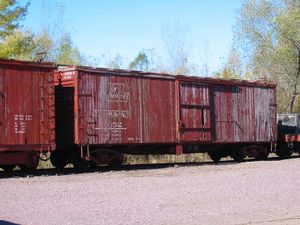Duluth, South Shore and Atlantic Railway
| Duluth, South Shore and Atlantic Railway | |
|---|---|
| Reporting marks | DSA |
| Locale | Michigan, Wisconsin |
| Dates of operation | 1855 – 1960 |
| Successor line | Soo Line |
| Track gauge | 4 ft 8½ in (1435 mm) (standard gauge) |
| Headquarters | Marquette, Michigan |
The Duluth, South Shore and Atlantic Railway (DSS&A) (AAR reporting marks DSA) was an American railroad serving the Upper Peninsula of Michigan and the Lake Superior shoreline of Wisconsin. It provided service from Sault Ste. Marie, Michigan, and St. Ignace, Michigan, westward through Marquette, Michigan to Superior, Wisconsin, and Duluth, Minnesota. A branchline stretched northward from Nestoria, Michigan up to the Keweenaw Peninsula and terminating at Houghton, Michigan, with trackage rights extending further to Calumet, Michigan.
The first predecessor of the DSS&A began operations in 1855. The railroad fell under the control of the Canadian Pacific Railway (CPR) in 1888, and was operated in 1888-1960 as an independently-nameplated subsidiary of the CPR. In 1949, a reorganization of the DSS&A took place, creating new heralds and designating the company a railroad (RR) instead of a railway (RY). In 1961, the DSS&A RR was folded into the CPR-controlled Soo Line Railroad. Since 2001, the remaining operating trackage of the former DSS&A has been operated by the Canadian National Railway (CN).
Independent railroad
The development in the 1850s of hematite iron ore mines in the Upper Peninsula hills above Marquette encouraged the development of numerous railroad plans for spur lines and connecting routes between mines, local boom towns, and the shores of the Great Lakes. While most of the Upper Peninsula's iron ore and Keweenaw copper was shipped to the rest of the United States by lake boat, the inability of water-based shippers to offer service to northern Michigan in winter encouraged railroad promoters to launch numerous plans for lines in the Upper Peninsula.
By the 1870s, a maze of corporate charters and tiny stub lines had been created or built in the central Upper Peninsula, primarily to carry iron or copper ore from the mines down to smelters and docks on the shores of Lake Superior and Lake Michigan. In 1879-81, venture capitalists led the construction of the Detroit, Mackinac & Marquette (DM&M), a standard-gauge main line from St. Ignace, on the Straits of Mackinac, to Marquette on Lake Superior. Although the state of Michigan granted the DM&M more than 1.3 million acres (5,300 km²) of state land, almost 9,000 acres per mile (23 km²/km) as a construction subsidy, by 1886 the new DM&M went into receivership.
The DM&M was reorganized by venture capitalist James McMillan of Detroit, who led the rapid consolidation of the DM&M and many of the UP's smaller railroads during the early 1880s. The new Duluth, South Shore & Atlantic went into operation as a merger of these lines in December 1886.
Canadian control
The Canadian Pacific Railway (CPR), transcontinental line, took control of the Duluth, South Shore & Atlantic in 1888. In 1892-94, CPR funds financed the construction of the DSS&A westward from the Keweenaw Peninsula to Duluth.
During the 1890s, the timber industry reached the peak of its operations on the Lake Superior shoreline properties adjacent to the DSS&A's new main line, with irreplaceable old-growth white pines falling to the lumbermen's saws and axes. After white pines were exhausted, local cutters began to turn to high-quality hardwoods such as sugar maple, and then to pulpwoods such as paper birch and aspen.
At the height of the railroad's operations in 1911, the DSS&A operated 623 miles (1,003 km) of track, of which 517 miles (832 km) were main line and 106 miles (171 km) were branch lines and trackage rights. The railroad operated 3,121 pieces of rolling stock, including 82 locomotives, 67 passenger cars, 35 cabooses, and 2,957 freight cars.[1]
In 1913 the DSS&A's freight operations peaked at almost 1 million tons (0.9 m tonnes), of which more than half were forest products. In the late 1910s, timber yields began to decline all over the Upper Peninsula. This was a blow from which the DSS&A could not recover as an independent nameplate. Its story from 1920 onwards was that of the American railway industry as a whole, with negative factors intensified by unfavorable local business conditions in northern Michigan.
In 1957, the state of Michigan opened the Mackinac Bridge, an all-weather hard road across the Straits of Mackinac into the Upper Peninsula. The DSS&A responded by ending its remaining passenger rail service in January 1958. There was now no reason for the short line to maintain its own identity, and in 1961 its Canadian owners folded it into a larger railroad they also owned, the Soo Line.
Popular culture
- Shortly after World War I, the alter ego of writer Ernest Hemingway, "Nick Adams", rode northwestward on the DSS&A from St. Ignace to his trout fishing hole in "Big Two-Hearted River".
- The DSS&A's allegedly poor-quality service throughout much of the 20th century led to many uncomplimentary nicknames being bestowed on the struggling railroad, such as "Dead Slow Service & Agony" and "Damn Slow, Shabby Affair".
- The DSS&A's own "official" nickname for itself was simply "South Shore", referring to the railroad line's route along the south shore of Lake Superior.
- The DSS&A's Lake Superior-affected former service territory receives more snowfall in many years than any other section of the United States east of the Rockies. From 1957 through 2005, the average snowfall on the Keweenaw Peninsula has been 241 inches (more than 20 feet) per year.
References
- ↑ (Spring 1969) "Duluth, South Shore & Atlantic Railway". Michigan History 53 (1): 62-72.

